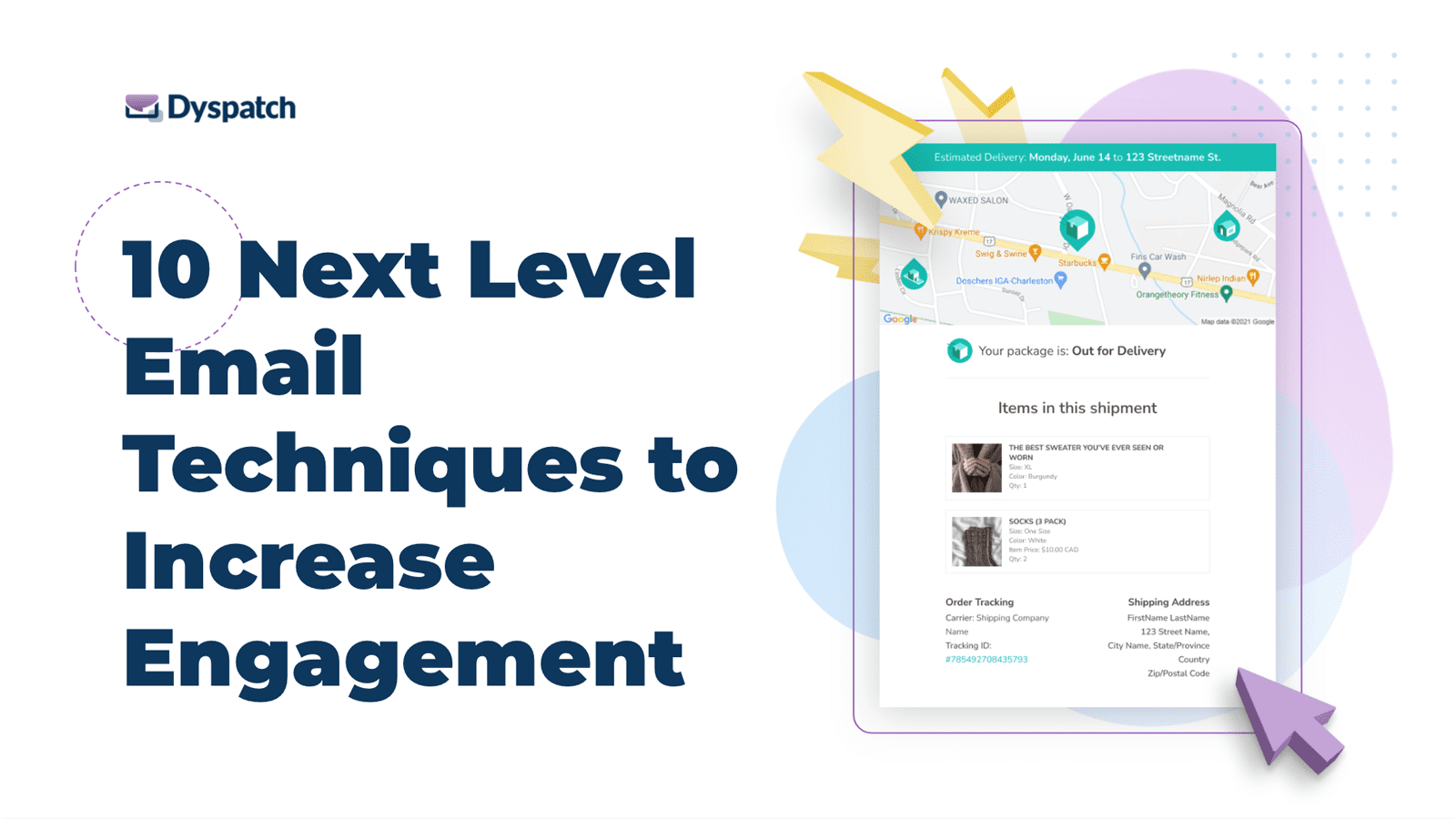Table of Contents
- Webinar Summary
- Setting the Stage
- What is AMP for Email?
- 10 Ways to Drastically Increase Engagement With Interactive AMP Emails
- #1 Book an Appointment
- #2 Embed a Form
- #3 Add to Cart
- #4 Live Commenting
- #5 Surveys
- #6 Pinned Content
- #7 Live carousels
- #8 Dynamic product lists
- #9 Notifications
- #10 Loan Sliders
- Bonus Round: What Else Can You Do With AMP for Email?
- Key Takeaways
Webinar Summary
Dyspatch recently had the opportunity to attend the MarTech Conference, where our Co-founder and CEO led an expert session on 10 next level email techniques to increase inbox engagement.
MarTech connects forward-thinking, senior-level marketers with innovative technology companies (like us!), sharing their new tools, techniques, and strategies.
What follows is a summary of this session, outlining:
- What is AMP for Email?
- 10 ways to drastically increase engagement with interactive AMP emails
- Key takeaways, including how to easily implement AMP
Send yourself a sample AMP email:
Poll in Email
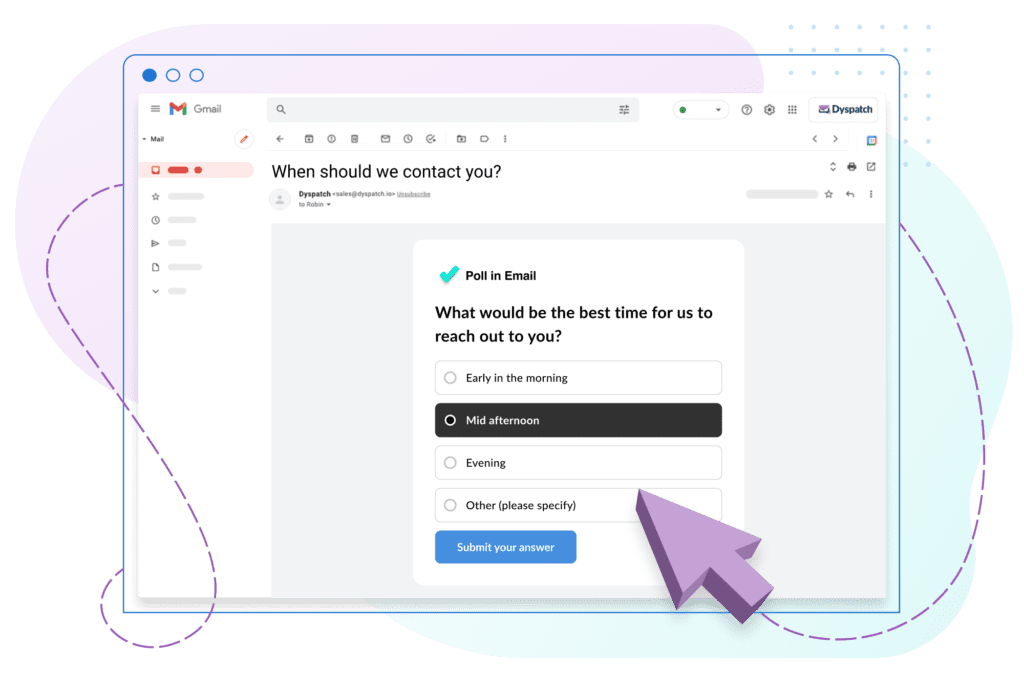
Increase response rates and serve up engaging inbox experiences with polls in email. Submit your email below to send yourself a sample AMP email.
Session Recap: 10 Next Level Email Techniques to Increase Engagement
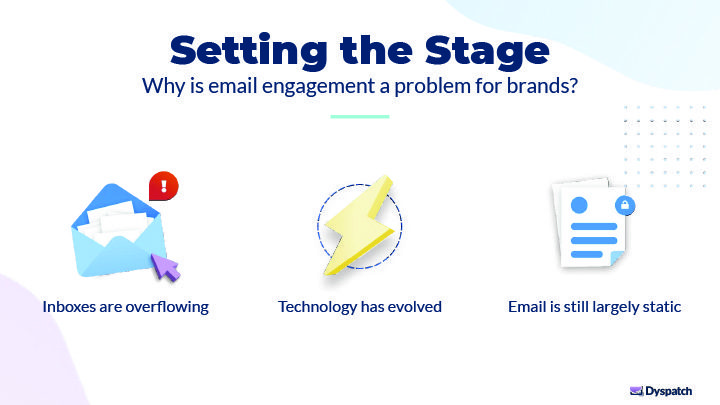
Setting the Stage
Let’s set the stage a little and cover why email engagement is a problem for brands today. Part of the problem is really simple – inboxes are overflowing. Companies are sending more emails. I refer to this as the “law of email” – every year, companies will send more emails, and you know people are getting more emails than ever before. So it’s an increasing challenge for you to compete in the inbox, let alone get that engagement you really need.
The other part of the problem here is a little more subtle, and it has to do with the evolution of technology and the way that consumers are being trained to interact with it. We’ve evolved to the point where people use their phones more than desktop computers. You’ve probably heard that more than half of all email opens are now happening on a phone. That stat gets bigger every year.
So what else do we do on our phones? We use apps. We use gestures, like swiping, clicking to expand and zoom in, which is a really active, engaging experience. In contrast, email is still a very static medium and it hasn’t evolved much since HTML. As things stand, it’s not as compelling as these other forms of interaction. The result of all this is a steady decline in email engagement.
So what can you do? You have to change the email experience. Make it “unstatic”. Make it app-like by bringing the same kind of interactivity that people are used to, into the inbox.
Luckily, I’m here to tell you, you can do this today with a super cool technology called AMP for Email. AMP is the biggest change to come to email since HTML. And there are endless possibilities with it. We’ll go over a few today, and you’ll come away with a ton of inspiration for interactive AMP email experiments to try. For those of you who aren’t familiar, I’ll start with a quick intro to AMP for Email and what it does.
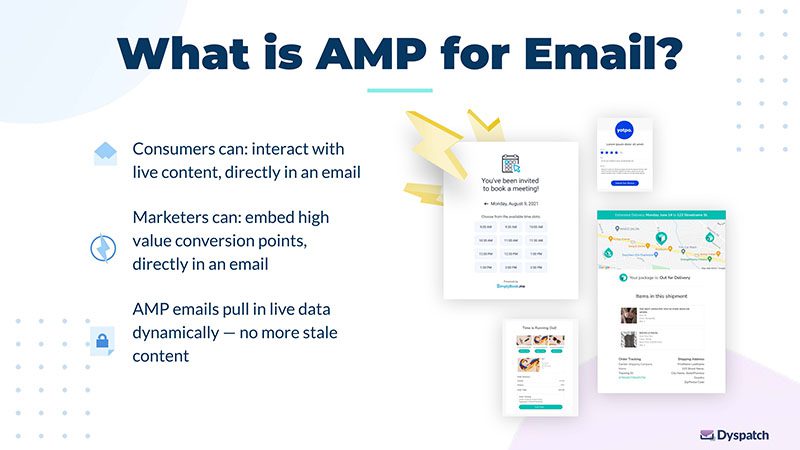
What is AMP for Email?
As promised, I’ll briefly go over what AMP for Email is.
AMP is an innovative Google technology that allows recipients to interact with live content right inside an email. Subscribers don’t need to click through to a webpage. With an AMP email, they take action directly in the inbox. And this isn’t just for Google. If your subscribers are using Yahoo or AOL, they can also receive these emails (as well as, hopefully in the next year or two, Microsoft Outlook and Office 360).
As an email marketer, what this means is that you can embed your high-value conversion points directly inside an email. And brands have reported huge increases in engagement – up to 500% – by eliminating that extra click or step. I’ll show you where that 500% comes from in a little bit.
The other aspect of AMP emails is that they can pull in live data dynamically. What does that mean? It means they are no longer static. They never show stale content. When a subscriber opens an AMP email, data is pulled in that applies to that very moment. For example, a subscriber would see the latest real estate listings or clearance products, and you wouldn’t have to worry about showing sold-out products or expired listings.
This represents a huge upgrade to the user experience and opens up a whole new realm of possibilities for email campaigns. As someone who has been getting email and working with email for a long time, I can’t tell you how real my excitement here is. This is really, really cool.
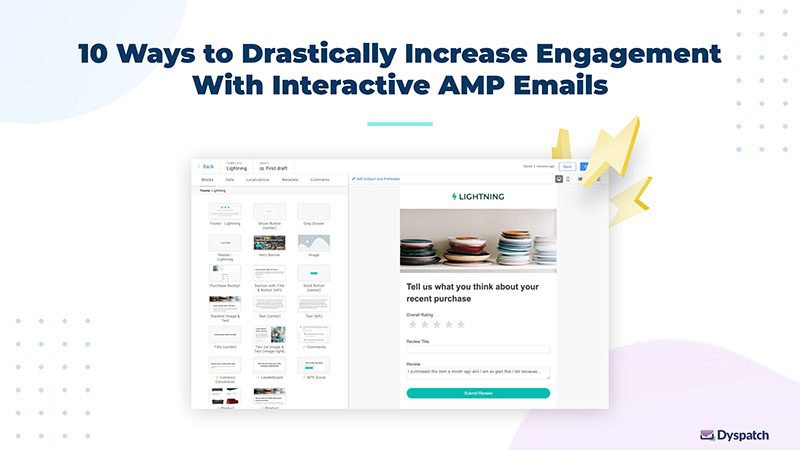
10 Ways to Drastically Increase Engagement With Interactive AMP Emails
Let’s jump into some of the possibilities. We’re going to go through 10 different ways brands are using AMP today to increase engagement.
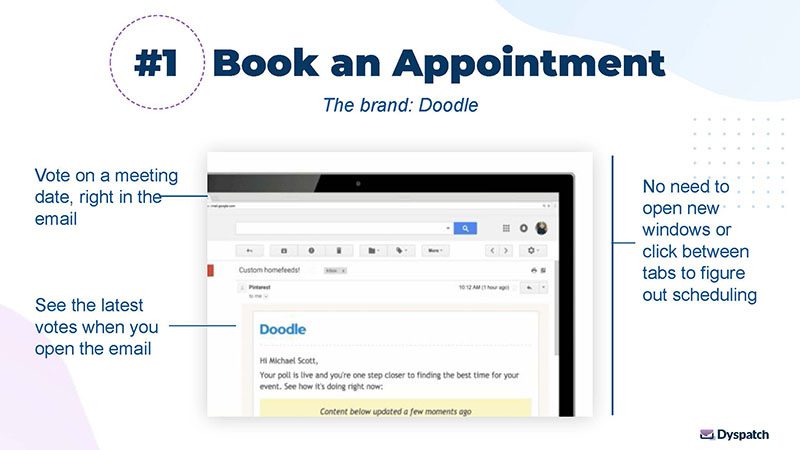
#1 Book an Appointment
The brand: Doodle
You’re probably familiar with Doodle. Very similar to Calendly, Doodle is an online calendar tool for scheduling and managing meetings when you have a bunch of different people with conflicting schedules. Doodle was actually one of the first companies to adopt AMP for Email.
In this example, the recipient is able to vote on a meeting date directly from the email. Anyone else who opens the email will see a live update of the latest votes. This eliminates the need to open up your calendar and a coworker’s calendar in another tab and click between the two windows and the scheduling site to find the right time. Or the possibility of seeing old info on the best meeting time in the email. Now you’re able to get it all done in your inbox in a dynamic manner. That’s super convenient.
The results
By implementing AMP emails, Doodle has set themselves up for success by making life easier for the users.
- Doodle users benefit from reduced friction and time saved, which is just a better user experience.
- Doodle gets increased engagement, which means more meetings booked.
The takeaways
Now, how could this apply to your business? There are a couple of different ways.
- If you’re in the B2B world, AMP emails make it easy for your leads or customers to book a demo or meeting with you based on your availability. That’s massive.
- For B2C, AMP emails make it easy for customers to book a reservation based on current availability. This is ideal functionality for restaurants, hair salons, airlines, and more.
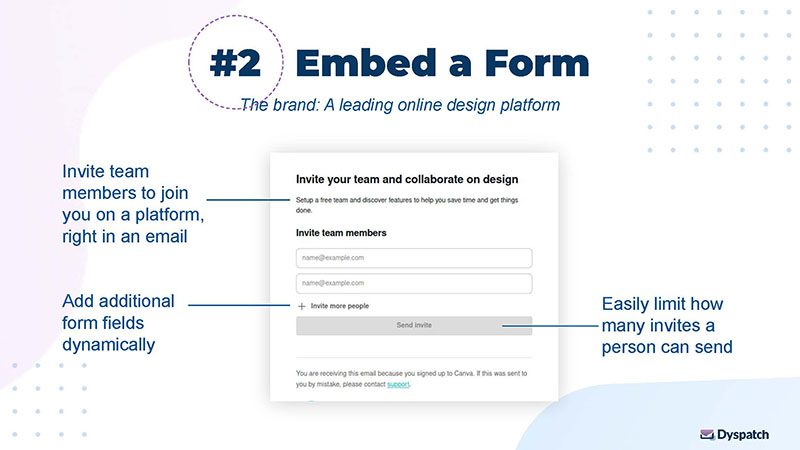
#2 Embed a Form
The brand: A leading online design platform
This is one of my favourite companies. I can’t call them out here directly, but I can tell you that they’re an awesome online design platform. And they use embedded AMP forms in their emails to facilitate team invitations.
In this example, the user can invite their team members to join them on said design platform, directly from the inbox. So they’re bringing the whole invitation workflow right into an email. There’s also the option to add additional dynamic form fields depending on how many team members the user wants to invite. It’s easy to limit how many invites a person can send from this email too.
So you can see, they’ve transformed the cumbersome process of clicking through to a webpage, waiting for it to load, and then filling out and sending the form there, into something that’s quick and easy to complete right in the inbox.
The results
With AMP, this design platform has created a smooth, efficient onboarding process. Both the platform and the users really benefit from this.
- More invitations sent means more users on the platform.
- A frictionless user experience means happier, more engaged customers. (It’s awesome!)
What I love about embed a form is every one of you probably has a form on your website or forms within your app that you’re driving customers to. With AMP, you can pull that form right into an email, and you can do it today.
The takeaways
Embed a form also has so many applications beyond onboarding. You can embed any kind of form into an AMP email. Product review requests, surveys, event RSVPs, account creation forms – whatever you can think of. Like I said, if you have it on your website, I challenge you to find me a form we can’t put inside an email for you.
- For B2B, embed a form can increase product adoption, product stickiness, and overall productivity.
- For B2C, AMP forms can be great for getting product reviews, feedback, valuable customer data, and building trust with your customers.
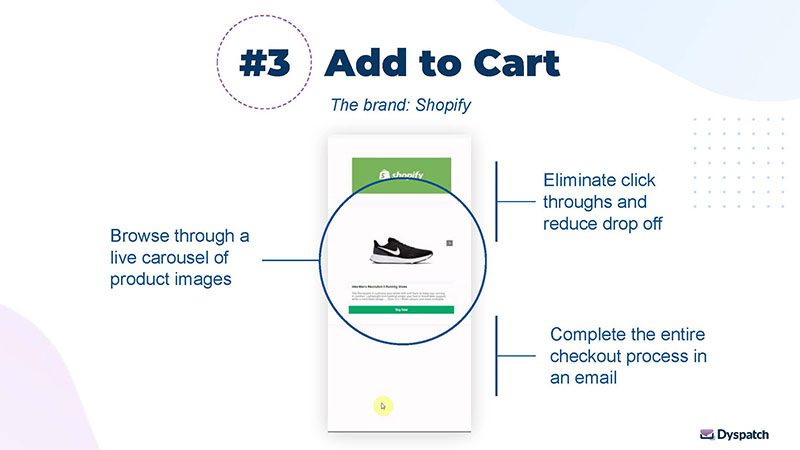
#3 Add to Cart
The brand: Shopify
This example is actually something we built here in-house at Dyspatch. We haven’t put it into practice yet – we’re looking for that right customer. For an all-in-one ecommerce platform like Shopify, the potential to increase sales and revenue with AMP is huge.
How? Let’s simplify the entire checkout process and bring all the high-value engagement points you have directly inside an email. In this example, the user can complete the entire checkout process directly inside an email. We call this inbox shopping.
Imagine if your customers could purchase directly from your email campaigns, instead of having to click through to a webpage and then scroll through products until they find the one that caught their eye. And then click through on a whole different page to complete the checkout process? Also, imagine how much more effective your abandoned cart emails could be (I’ve got more on that later).
The results
As I said, we haven’t launched this with a customer yet, but many brands are already halfway there. Nest, one of Google’s brands, has some great AMP emails where you can pick customized items and then add them to your cart directly inside the email. They’ve seen great results from this, consistent with other AMP email use cases.
- With this app, we expect to see less clicks, which means more conversions and sales.
- An alternative checkout option is going to lead to more checkouts.
The takeaways
Inbox shopping is 100% possible today. I know it because we built it. And the possibilities for increasing sales are huge.
- By bringing the entire checkout process into an email, brands can significantly increase sales and revenue.
- Although this is primarily a B2C use case, I think B2B businesses could offer checkout functionality as well. For example, you could upgrade a service plan directly from an email.
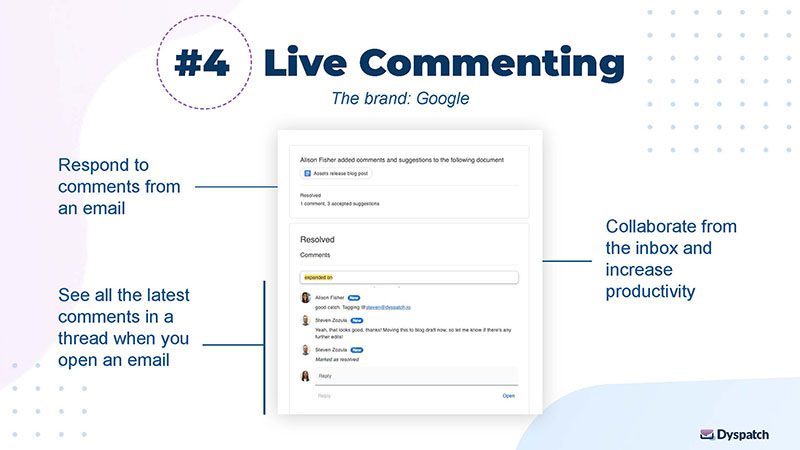
#4 Live Commenting
The brand: Google
This is the classic AMP example. Google uses their own technology to allow users to respond to comments directly from an email. Since these are AMP emails, they also pull in live data when the user opens them. So if someone adds a comment to a chain after the notification is sent, the user will see it when they open their email. I don’t know about you, but I take advantage of this all the time because I use Google Drive and Google Docs a lot. And it’s so much easier and quicker to respond to a comment in an email when I see it than to come back to it later or try to click through to the document and find the thread.
This use case adds value for Google Doc users by making life easier for them and increasing productivity – all of which results in better customer retention and lifetime value.
The results
Google saw truly impressive results when they implemented AMP live commenting emails. Remember that engagement stat I gave you of 500%? That’s from Google. They reported a 500% increase in comment responses after implementing these AMP emails.
- Live in-email commenting means 500% more comments and just plain easy collaboration.
- A more efficient user experience means higher productivity, engagement, and product stickiness.
The takeaways
Live commenting is such a great productivity use case, and it can be applied to so many platforms. Some quick ideas here:
- For B2B businesses with any kind of collaborative platform or tool, AMP live comment notification emails or task update emails would increase engagement with your platform, provide a superior user experience, and promote customer retention.
- For B2C, the same concept could be applied in a different way. For example, you could include a live chat in an AMP email that allows your customers to ask questions or connect directly with your support team.
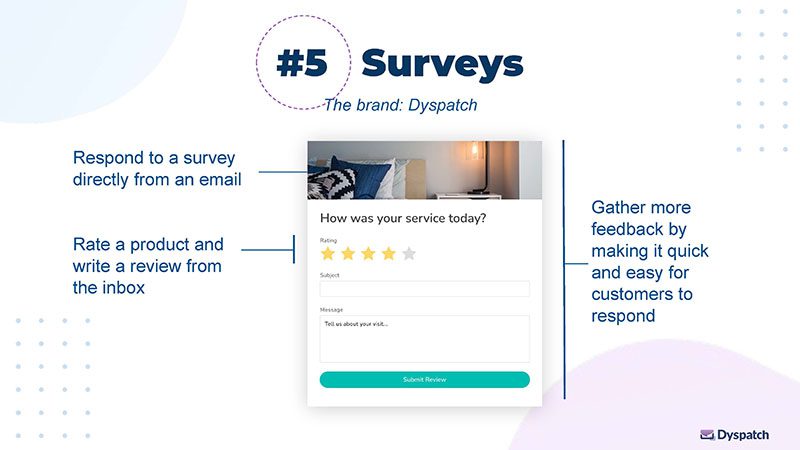
#5 Surveys
The brand: Dyspatch
This example is actually from my own company, Dyspatch. We’re making implementing AMP super easy with pre-coded apps that you can simply drag and drop into your existing email. And one of those key apps is for surveys.
In this example, the user can respond to a survey directly in an email. They can rate the product, add a review title, add their comment, and then submit their review directly from the inbox. Again, a super handy way of getting valuable customer feedback whether you’re a B2B or B2C business.
The results
There have been a few experiments done that compare the performance of static HTML email surveys versus an AMP email survey, and I’m excited to tell you the results show a 5x increase in responses from the AMP survey results. This is consistent with the results we’ve seen from Google and across the board. It boils down to:
- No more click-throughs means 5x more survey completions.
- A frictionless survey experience means increased engagement and a faster turnaround time on surveys.
The takeaways
This is really similar to the form example we went over earlier, and this one has a ton of applications. And really, a survey is actually just a type of form. But whether you’re asking for feedback on an event, product, or customer service interaction, AMP can help you get more responses, more data to back up your marketing strategy, and more social proof to build proof with your audience.
- For B2B, interactive AMP email surveys can help you gather feedback on events, product updates, customer satisfaction and more.
- For B2C, I think these surveys are a great way to get more product reviews and invaluable social proof.
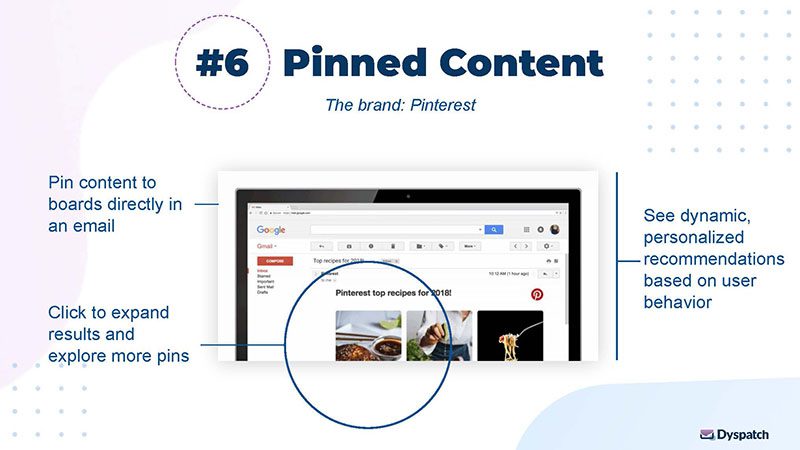
#6 Pinned Content
The brand: Pinterest
Coming to us from the king of pins – Pinterest. They’re one of the first to adopt AMP emails as well. As a social media platform that allows users to pin content to different boards, the obvious AMP use case would be to pin content in emails – and that’s exactly what they experimented with.
In this example, the user can pin content within the email, as well as load additional pins. Content is always recommended dynamically, based on what the users were browsing from one day to the next. So they’re serving up a highly personalized, interactive email experience.
The results
Let’s see how it did. Pinterest reported that given the option, 20% more people were pinning content within the email. That’s a pretty nice bump in engagement.
- This alternative user experience resulted in 20% more pins and engagement.
- A better user experience led to higher user retention.
The takeaways
This also has a ton of applications. A service like Netflix could let you add shows and movies directly to your queue, from an email full of personalized recommendations. Spotify could let you build a playlist in an email. Instagram could allow you to follow influences from an email. Do you see where I’m going with this?
- Consumer platforms like streaming services or social media could apply “add to queue” or “pinned content” AMP emails to boost engagement and retain customers.
- This could be applied to B2B businesses as well – for example, a SaaS company could let you bookmark a blog or white paper to read at a later date.
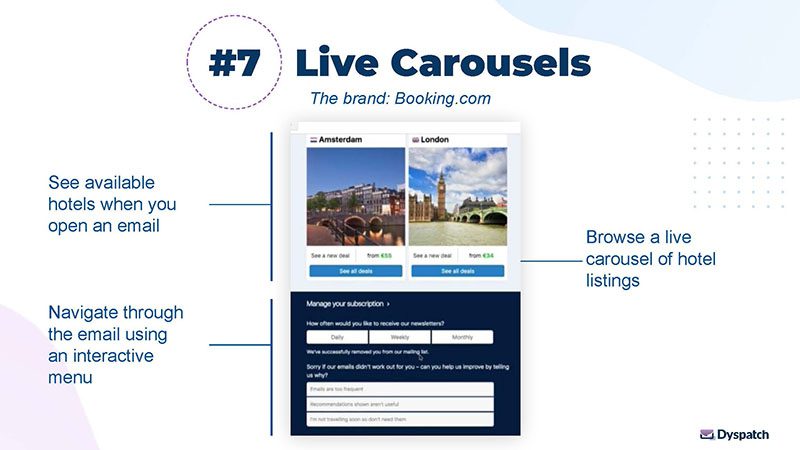
#7 Live carousels
The brand: Booking.com
I really love this example from Booking.com because it showcases the power of live, dynamic data. Booking.com is, of course, a hotel booking site. And they were another early adopter of AMP emails, and they’ve seen some really impressive results.
In this example, the user sees what hotels are available when they actually open the email, not when it’s sent. So you never have to worry about a poor user experience of someone opening one of their emails and getting excited about that perfect hotel, only to find out it’s all booked up when they click through.
The user can also navigate through this email using the interactive menu at the top. They simply select their desired destination, and a live carousel of available listings pops up. All in all, this is really close to the user experience that a user would have on the booking website, or on the booking app, which is super neat. I call this Apps in Email, and that’s really how we should be thinking about this.
The results
Booking.com continues to send AMP emails to this day, and they’re implementing new AMP features all the time. My bet is that their engagement on these emails is way up. They recently added the ability to manage email preferences from directly inside the email (instead of just unsubscribing). So users can personalize the timing of their emails, which is really clever.
- Live listings meant no more stale content and a better user experience.
- More relevant listings is always going to mean more bookings.
The takeaway
For the travel and real estate industries, this use case is especially compelling. Hotels often only have a few rooms available, and real estate, well, once a listing is sold, that’s it. So being able to pull in a live carousel of available properties is a huge upgrade to the email experience.
- Travel and real estate businesses can use AMP email live carousels to promote the latest listings and promote sales and increase revenue.
- For B2B, there are use cases where live carousels would come in handy too. For example, if you share blogs often you could include a carousel of your latest post that would be up-to-date whenever someone opens the email. You could also personalize that, based on their interests.

#8 Dynamic product lists
The brand: Ecwid
This example comes to us from Ecwid, an ecommerce platform that’s helped many of its merchants increase sales with AMP emails. Traditionally, it can be really hard to promote low-stock products through email for fear of providing a poor user experience. You never want someone to get excited about the product and then click through, and it’s out of stock on the website. But with dynamic AMP product lists, that’s no longer an issue.
In this example, the user sees a live list of in-stock products that’s pulled when they open the email. They’re also able to interact with the email by clicking to view a product description and zooming in on the product itself. Ecwid has seen great success by implementing these functions in abandoned cart emails in particular.
The results
With their AMP abandoned cart emails, Ecwid reports an average increase on recovered sales of 82%. If you combine this with our inbox shopping app, you could see some truly impressive results. One merchant at Ecwid even reported they increased recovered sales by 300%. Clearly, the dynamic, interactive nature of these emails had a big impact on conversions and sales.
So what did we learn?
- Live product lists means a way better user experience.
- Interactive features can mean up to 300% more conversions. (I can’t guarantee you’re going to see 300%, but I will say you’re definitely going to see an increase in conversions!)
The takeaway
This use case has some really widespread applications and really changes what ecommerce brands can do in email. Before, it was risky and ill-advised to promote clearance items in an email. You just don’t want someone getting their heart set on a product, only to find it’s sold out when they click through to the site. Yet, clearance products are actually very compelling. So what is an email marketer to do? There’s finally an answer, and it’s AMP.
- For ecommerce and retail businesses, dynamic AMP product lists make it possible to promote low-stock products in email and increase sales.
- For B2B, there are live list applications too. I shared an example earlier of pulling in the latest blogs to an email, but you can do pretty much anything.

#9 Notifications
The brand: VOGSY
I know we’ve already seen a lot of great examples of how AMP can have a direct impact on engagement and ROI, so I wanted to share a productivity use case here.
If you’re not familiar, VOGSY is a professional services automation platform. Basically, it’s like a centralized platform for managing up to 60 different workflows. To help their users take action and move through workflows, they send approval and notification emails. And a lot of them, as you can imagine.
In this example, the user is able to take the required action directly from the inbox. So whether that’s hitting approve or replying to a new comment, they can do that right from the email notification. The user no longer has to click through and potentially log into the platform to get something done. This is super convenient for busy professionals.
The results
After implementing AMP and transforming these emails into actionable interactive experiences, VOGSY reported that actions are completed 80% faster. For context, it used to take on average a day for users to complete some of these actions. And now, actions are completed within an hour or two. That’s a massive productivity win.
- For users, the in-email actions led to actions completed 80% faster and increased productivity.
- For VOGSY, now they’re offering more value – increasing customer satisfaction and retention.
The takeaways
If you can make your product more useful and easier for your customers to use, that’s always a win. And that’s what VOGSY has accomplished by implementing AMP notification emails. Any project management or collaborative SaaS platform could do exactly the same.
- For collaborative platforms, AMP notification emails can increase engagement, productivity, and ultimately customer retention and lifetime value.
- This could be applied to B2C business, too – for example, a delivery service could send you live shipping notification emails (you’ll get more on this later). Or they could use AMP emails to confirm your availability or choose a timeslot for the delivery right in your inbox.
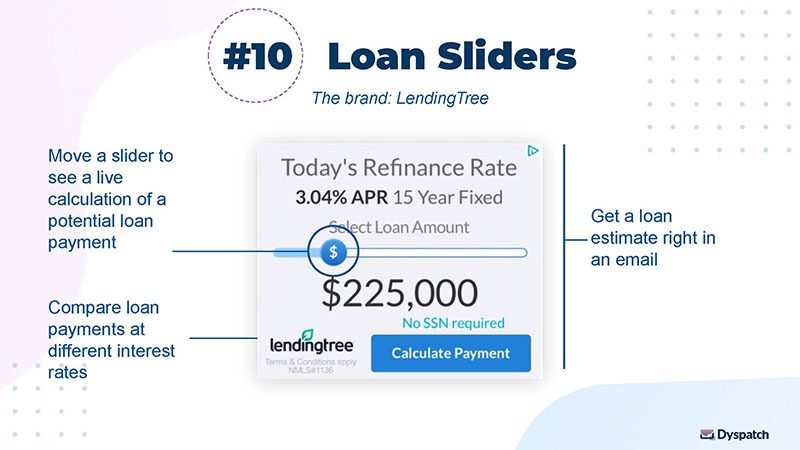
#10 Loan Sliders
The brand: LendingTree
This one comes to us from LendingTree, which is a personal loan service, and they use AMP to share an interactive personal loan slider, right in an email. This is definitely a next-level engagement technique. I mean, it’s really hard to resist trying this out in the email.
In this example, the user can move the slider left or right and data, like an interest rate versus monthly payment, will automatically update. So the users can see exactly what their loan would look like without ever leaving the inbox. Super interactive and definitely very cool.
The results
LendingTree has also seen some very compelling results with AMP. Though we don’t have the exact numbers on the loan slider example, they also send out interactive AMP quizzes that users can complete in an email. Once completed, the user gets paired up with a financial planner. And with that experiment, they saw an 86% increase in click-through rate. So we know that AMP emails are delivering results for them.
- The live product example (which is basically demoing a product in an email) led to increased engagement.
- Their interactive email elements led to 86% more click-throughs.
The takeaways
Loan sliders are just the tip of the iceberg. You could do a mortgage calculator, a budget planning quiz – whatever you can think of. This type of interactive experience is really hard to resist. It’s also highly personalized, which, as we all know, is a surefire way to increase engagement and conversions.
- For any kind of financial services, real estate services, and more, interactive AMP sliders and calculators can greatly increase engagement in the inbox.
- For B2B businesses, there are plenty of applications as well. For example, at Dyspatch, we have an ROI calculator that we can include in AMP email to show the value of our product to our customers and how we’re going to increase efficiency in email.

Bonus Round: What Else Can You Do With AMP for Email?
I know that was a ton of different examples – all ten of them – and I hope you’re feeling really inspired right now. I hope you feel that there’s something new in email, and it doesn’t have to be stale anymore. Because that’s what we’re going for.
I have a few bonus ideas here too, to get your mind going and get some ideas flowing.
Live shipping notification emails – I said I’d touch on this again, and it’s really worth expanding on. With AMP, you wouldn’t have to send multiple shipping notification emails anymore. You could send just one, and it would update to show the latest status of a parcel every time the user opens the email. You wouldn’t have to click through multiple pages to see an update. This is super handy, and we built this.
Gamification and reveal marketing – Gamification is not necessarily in vogue right now, but it’s definitely something you could do with AMP in email as well. Gamification would involve adding a game like a puzzle to your email. When the user solves it, they can get a reward like a discount code. This is called reveal marketing, and it’s been shown to greatly increase engagement as well (it’s hard to resist a game).
Referral campaigns – I mean, who doesn’t love a great referral program, but referrals are also one of the best ways to acquire new customers, and referred customers tend to stick around longer. With AMP, you can make it super easy to refer a friend right in an email.
Personalized upsells – This one ties into what we covered with dynamic product recommendations, but you could apply it to your B2C emails today, by sharing personalized upsells based on what’s in their cart right at that moment. For B2B, one example of this would be upselling different features in an order confirmation email based on product usage.
Managing preferences – So this is a personal favourite of mine. Who hates trying to change your subscription preferences, when you click through, and get to some webpage that doesn’t make sense, or you have to log in again – it’s a real pain. So let’s enable managing subscriptions preferences directly in the email. Not necessarily unsubscribe – maybe I just want to back it out to once a month or once every two weeks. You can do this with AMP at the bottom of your email. Spoiler alert: it’s using a form, and it can look great and make your customers really happy.

Key Takeaways
Let’s look at some takeaways.
- AMP is definitely the future of email. Email engagement has been steadily declining the past few years, and in order to remain relevant in the inbox and continue to see high ROI, brands need to reimagine email as an interactive, app-like experience.
- I hope you believe this now from these examples I’ve shown you, but implementing AMP emails will help your brand stand out in these saturated inboxes and increase engagement. I can’t guarantee that 500% lift, but let’s hope we can get you really close to it.
- AMP emails are also proven to deliver significant ROI compared to standard HTML. And the number of AMP use cases continues to grow, and the results are consistently impressive.
- Finally, with Dyspatch, you can easily implement AMP emails today into your existing emails, using our library of pre-coded, pre-approved email apps. We’re calling this technology Apps in Email. Maybe you’ve thought about trying AMP but dismissed it because the code is too complex or hard to implement. At Dyspatch, we’ve actually heard this already from many brands. That’s why we’re on a mission to democratize AMP. With our platform, anyone can create AMP emails in minutes, with built-in fallbacks for peace of mind and no coding skills required.

#3 Add to Cart
The brand: Shopify
This example is actually something we built here in-house at Dyspatch. We haven’t put it into practice yet – we’re looking for that right customer. For an all-in-one ecommerce platform like Shopify, the potential to increase sales and revenue with AMP is huge.
How? Let’s simplify the entire checkout process and bring all the high-value engagement points you have directly inside an email. In this example, the user can complete the entire checkout process directly inside an email. We call this inbox shopping.
Imagine if your customers could purchase directly from your email campaigns, instead of having to click through to a webpage and then scroll through products until they find the one that caught their eye. And then click through on a whole different page to complete the checkout process? Also, imagine how much more effective your abandoned cart emails could be (I’ve got more on that later).
The results
As I said, we haven’t launched this with a customer yet, but many brands are already halfway there. Nest, one of Google’s brands, has some great AMP emails where you can pick customized items and then add them to your cart directly inside the email. They’ve seen great results from this, consistent with other AMP email use cases.
- With this app, we expect to see less clicks, which means more conversions and sales.
- An alternative checkout option is going to lead to more checkouts.
The takeaways
Inbox shopping is 100% possible today. I know it because we built it. And the possibilities for increasing sales are huge.
- By bringing the entire checkout process into an email, brands can significantly increase sales and revenue.
- Although this is primarily a B2C use case, I think B2B businesses could offer checkout functionality as well. For example, you could upgrade a service plan directly from an email.
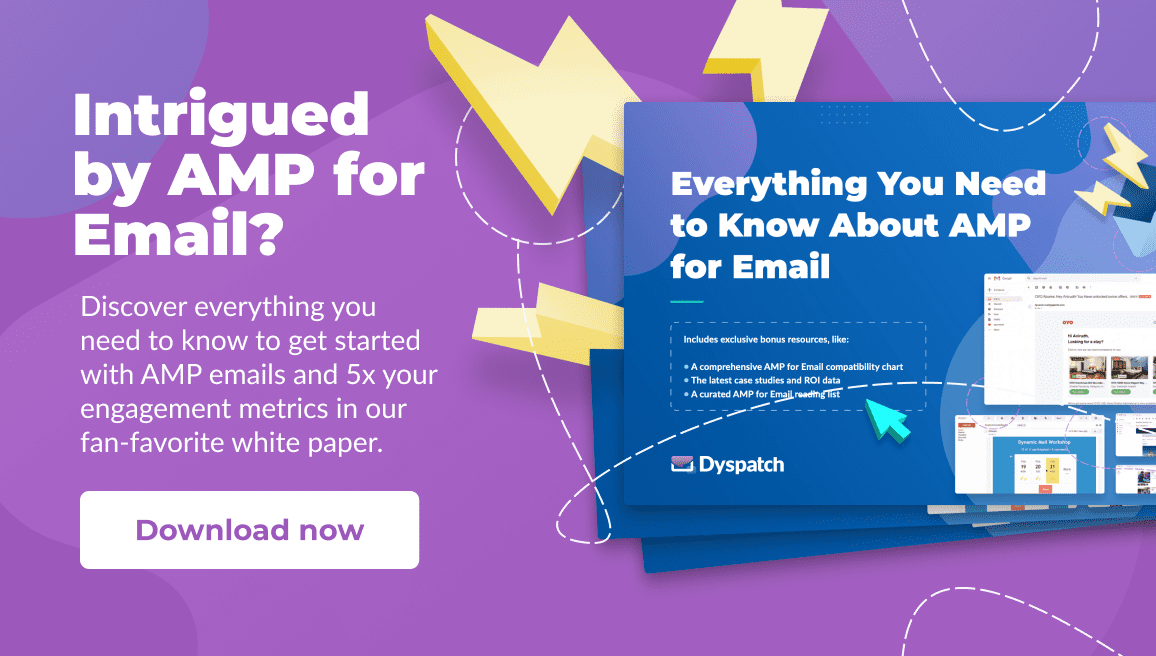

#4 Live Commenting
The brand: Google
This is the classic AMP example. Google uses their own technology to allow users to respond to comments directly from an email. Since these are AMP emails, they also pull in live data when the user opens them. So if someone adds a comment to a chain after the notification is sent, the user will see it when they open their email. I don’t know about you, but I take advantage of this all the time because I use Google Drive and Google Docs a lot. And it’s so much easier and quicker to respond to a comment in an email when I see it than to come back to it later or try to click through to the document and find the thread.
This use case adds value for Google Doc users by making life easier for them and increasing productivity – all of which results in better customer retention and lifetime value.
The results
Google saw truly impressive results when they implemented AMP live commenting emails. Remember that engagement stat I gave you of 500%? That’s from Google. They reported a 500% increase in comment responses after implementing these AMP emails.
- Live in-email commenting means 500% more comments and just plain easy collaboration.
- A more efficient user experience means higher productivity, engagement, and product stickiness.
The takeaways
Live commenting is such a great productivity use case, and it can be applied to so many platforms. Some quick ideas here:
- For B2B businesses with any kind of collaborative platform or tool, AMP live comment notification emails or task update emails would increase engagement with your platform, provide a superior user experience, and promote customer retention.
- For B2C, the same concept could be applied in a different way. For example, you could include a live chat in an AMP email that allows your customers to ask questions or connect directly with your support team.

#5 Surveys
The brand: Dyspatch
This example is actually from my own company, Dyspatch. We’re making implementing AMP super easy with pre-coded apps that you can simply drag and drop into your existing email. And one of those key apps is for surveys.
In this example, the user can respond to a survey directly in an email. They can rate the product, add a review title, add their comment, and then submit their review directly from the inbox. Again, a super handy way of getting valuable customer feedback whether you’re a B2B or B2C business.
The results
There have been a few experiments done that compare the performance of static HTML email surveys versus an AMP email survey, and I’m excited to tell you the results show a 5x increase in responses from the AMP survey results. This is consistent with the results we’ve seen from Google and across the board. It boils down to:
- No more click-throughs means 5x more survey completions.
- A frictionless survey experience means increased engagement and a faster turnaround time on surveys.
The takeaways
This is really similar to the form example we went over earlier, and this one has a ton of applications. And really, a survey is actually just a type of form. But whether you’re asking for feedback on an event, product, or customer service interaction, AMP can help you get more responses, more data to back up your marketing strategy, and more social proof to build proof with your audience.
- For B2B, interactive AMP email surveys can help you gather feedback on events, product updates, customer satisfaction and more.
- For B2C, I think these surveys are a great way to get more product reviews and invaluable social proof.

#6 Pinned Content
The brand: Pinterest
Coming to us from the king of pins – Pinterest. They’re one of the first to adopt AMP emails as well. As a social media platform that allows users to pin content to different boards, the obvious AMP use case would be to pin content in emails – and that’s exactly what they experimented with.
In this example, the user can pin content within the email, as well as load additional pins. Content is always recommended dynamically, based on what the users were browsing from one day to the next. So they’re serving up a highly personalized, interactive email experience.
The results
Let’s see how it did. Pinterest reported that given the option, 20% more people were pinning content within the email. That’s a pretty nice bump in engagement.
- This alternative user experience resulted in 20% more pins and engagement.
- A better user experience led to higher user retention.
The takeaways
This also has a ton of applications. A service like Netflix could let you add shows and movies directly to your queue, from an email full of personalized recommendations. Spotify could let you build a playlist in an email. Instagram could allow you to follow influences from an email. Do you see where I’m going with this?
- Consumer platforms like streaming services or social media could apply “add to queue” or “pinned content” AMP emails to boost engagement and retain customers.
- This could be applied to B2B businesses as well – for example, a SaaS company could let you bookmark a blog or white paper to read at a later date.

#7 Live carousels
The brand: Booking.com
I really love this example from Booking.com because it showcases the power of live, dynamic data. Booking.com is, of course, a hotel booking site. And they were another early adopter of AMP emails, and they’ve seen some really impressive results.
In this example, the user sees what hotels are available when they actually open the email, not when it’s sent. So you never have to worry about a poor user experience of someone opening one of their emails and getting excited about that perfect hotel, only to find out it’s all booked up when they click through.
The user can also navigate through this email using the interactive menu at the top. They simply select their desired destination, and a live carousel of available listings pops up. All in all, this is really close to the user experience that a user would have on the booking website, or on the booking app, which is super neat. I call this Apps in Email, and that’s really how we should be thinking about this.
The results
Booking.com continues to send AMP emails to this day, and they’re implementing new AMP features all the time. My bet is that their engagement on these emails is way up. They recently added the ability to manage email preferences from directly inside the email (instead of just unsubscribing). So users can personalize the timing of their emails, which is really clever.
- Live listings meant no more stale content and a better user experience.
- More relevant listings is always going to mean more bookings.
The takeaway
For the travel and real estate industries, this use case is especially compelling. Hotels often only have a few rooms available, and real estate, well, once a listing is sold, that’s it. So being able to pull in a live carousel of available properties is a huge upgrade to the email experience.
- Travel and real estate businesses can use AMP email live carousels to promote the latest listings and promote sales and increase revenue.
- For B2B, there are use cases where live carousels would come in handy too. For example, if you share blogs often you could include a carousel of your latest post that would be up-to-date whenever someone opens the email. You could also personalize that, based on their interests.

#8 Dynamic product lists
The brand: Ecwid
This example comes to us from Ecwid, an ecommerce platform that’s helped many of its merchants increase sales with AMP emails. Traditionally, it can be really hard to promote low-stock products through email for fear of providing a poor user experience. You never want someone to get excited about the product and then click through, and it’s out of stock on the website. But with dynamic AMP product lists, that’s no longer an issue.
In this example, the user sees a live list of in-stock products that’s pulled when they open the email. They’re also able to interact with the email by clicking to view a product description and zooming in on the product itself. Ecwid has seen great success by implementing these functions in abandoned cart emails in particular.
The results
With their AMP abandoned cart emails, Ecwid reports an average increase on recovered sales of 82%. If you combine this with our inbox shopping app, you could see some truly impressive results. One merchant at Ecwid even reported they increased recovered sales by 300%. Clearly, the dynamic, interactive nature of these emails had a big impact on conversions and sales.
So what did we learn?
- Live product lists means a way better user experience.
- Interactive features can mean up to 300% more conversions. (I can’t guarantee you’re going to see 300%, but I will say you’re definitely going to see an increase in conversions!)
The takeaway
This use case has some really widespread applications and really changes what ecommerce brands can do in email. Before, it was risky and ill-advised to promote clearance items in an email. You just don’t want someone getting their heart set on a product, only to find it’s sold out when they click through to the site. Yet, clearance products are actually very compelling. So what is an email marketer to do? There’s finally an answer, and it’s AMP.
- For ecommerce and retail businesses, dynamic AMP product lists make it possible to promote low-stock products in email and increase sales.
- For B2B, there are live list applications too. I shared an example earlier of pulling in the latest blogs to an email, but you can do pretty much anything.

#8 Dynamic product lists
The brand: Ecwid
This example comes to us from Ecwid, an ecommerce platform that’s helped many of its merchants increase sales with AMP emails. Traditionally, it can be really hard to promote low-stock products through email for fear of providing a poor user experience. You never want someone to get excited about the product and then click through, and it’s out of stock on the website. But with dynamic AMP product lists, that’s no longer an issue.
In this example, the user sees a live list of in-stock products that’s pulled when they open the email. They’re also able to interact with the email by clicking to view a product description and zooming in on the product itself. Ecwid has seen great success by implementing these functions in abandoned cart emails in particular.
The results
With their AMP abandoned cart emails, Ecwid reports an average increase on recovered sales of 82%. If you combine this with our inbox shopping app, you could see some truly impressive results. One merchant at Ecwid even reported they increased recovered sales by 300%. Clearly, the dynamic, interactive nature of these emails had a big impact on conversions and sales.
So what did we learn?
- Live product lists means a way better user experience.
- Interactive features can mean up to 300% more conversions. (I can’t guarantee you’re going to see 300%, but I will say you’re definitely going to see an increase in conversions!)
The takeaway
This use case has some really widespread applications and really changes what ecommerce brands can do in email. Before, it was risky and ill-advised to promote clearance items in an email. You just don’t want someone getting their heart set on a product, only to find it’s sold out when they click through to the site. Yet, clearance products are actually very compelling. So what is an email marketer to do? There’s finally an answer, and it’s AMP.
- For ecommerce and retail businesses, dynamic AMP product lists make it possible to promote low-stock products in email and increase sales.
- For B2B, there are live list applications too. I shared an example earlier of pulling in the latest blogs to an email, but you can do pretty much anything.

#9 Notifications
The brand: VOGSY
I know we’ve already seen a lot of great examples of how AMP can have a direct impact on engagement and ROI, so I wanted to share a productivity use case here.
If you’re not familiar, VOGSY is a professional services automation platform. Basically, it’s like a centralized platform for managing up to 60 different workflows. To help their users take action and move through workflows, they send approval and notification emails. And a lot of them, as you can imagine.
In this example, the user is able to take the required action directly from the inbox. So whether that’s hitting approve or replying to a new comment, they can do that right from the email notification. The user no longer has to click through and potentially log into the platform to get something done. This is super convenient for busy professionals.
The results
After implementing AMP and transforming these emails into actionable interactive experiences, VOGSY reported that actions are completed 80% faster. For context, it used to take on average a day for users to complete some of these actions. And now, actions are completed within an hour or two. That’s a massive productivity win.
- For users, the in-email actions led to actions completed 80% faster and increased productivity.
- For VOGSY, now they’re offering more value – increasing customer satisfaction and retention.
The takeaways
If you can make your product more useful and easier for your customers to use, that’s always a win. And that’s what VOGSY has accomplished by implementing AMP notification emails. Any project management or collaborative SaaS platform could do exactly the same.
- For collaborative platforms, AMP notification emails can increase engagement, productivity, and ultimately customer retention and lifetime value.
- This could be applied to B2C business, too – for example, a delivery service could send you live shipping notification emails (you’ll get more on this later). Or they could use AMP emails to confirm your availability or choose a timeslot for the delivery right in your inbox.

#10 Loan Sliders
The brand: LendingTree
This one comes to us from LendingTree, which is a personal loan service, and they use AMP to share an interactive personal loan slider, right in an email. This is definitely a next-level engagement technique. I mean, it’s really hard to resist trying this out in the email.
In this example, the user can move the slider left or right and data, like an interest rate versus monthly payment, will automatically update. So the users can see exactly what their loan would look like without ever leaving the inbox. Super interactive and definitely very cool.
The results
LendingTree has also seen some very compelling results with AMP. Though we don’t have the exact numbers on the loan slider example, they also send out interactive AMP quizzes that users can complete in an email. Once completed, the user gets paired up with a financial planner. And with that experiment, they saw an 86% increase in click-through rate. So we know that AMP emails are delivering results for them.
- The live product example (which is basically demoing a product in an email) led to increased engagement.
- Their interactive email elements led to 86% more click-throughs.
The takeaways
Loan sliders are just the tip of the iceberg. You could do a mortgage calculator, a budget planning quiz – whatever you can think of. This type of interactive experience is really hard to resist. It’s also highly personalized, which, as we all know, is a surefire way to increase engagement and conversions.
- For any kind of financial services, real estate services, and more, interactive AMP sliders and calculators can greatly increase engagement in the inbox.
- For B2B businesses, there are plenty of applications as well. For example, at Dyspatch, we have an ROI calculator that we can include in AMP email to show the value of our product to our customers and how we’re going to increase efficiency in email.

Bonus Round: What Else Can You Do With AMP for Email?
I know that was a ton of different examples – all ten of them – and I hope you’re feeling really inspired right now. I hope you feel that there’s something new in email, and it doesn’t have to be stale anymore. Because that’s what we’re going for.
I have a few bonus ideas here too, to get your mind going and get some ideas flowing.
Live shipping notification emails – I said I’d touch on this again, and it’s really worth expanding on. With AMP, you wouldn’t have to send multiple shipping notification emails anymore. You could send just one, and it would update to show the latest status of a parcel every time the user opens the email. You wouldn’t have to click through multiple pages to see an update. This is super handy, and we built this.
Gamification and reveal marketing – Gamification is not necessarily in vogue right now, but it’s definitely something you could do with AMP in email as well. Gamification would involve adding a game like a puzzle to your email. When the user solves it, they can get a reward like a discount code. This is called reveal marketing, and it’s been shown to greatly increase engagement as well (it’s hard to resist a game).
Referral campaigns – I mean, who doesn’t love a great referral program, but referrals are also one of the best ways to acquire new customers, and referred customers tend to stick around longer. With AMP, you can make it super easy to refer a friend right in an email.
Personalized upsells – This one ties into what we covered with dynamic product recommendations, but you could apply it to your B2C emails today, by sharing personalized upsells based on what’s in their cart right at that moment. For B2B, one example of this would be upselling different features in an order confirmation email based on product usage.
Managing preferences – So this is a personal favourite of mine. Who hates trying to change your subscription preferences, when you click through, and get to some webpage that doesn’t make sense, or you have to log in again – it’s a real pain. So let’s enable managing subscriptions preferences directly in the email. Not necessarily unsubscribe – maybe I just want to back it out to once a month or once every two weeks. You can do this with AMP at the bottom of your email. Spoiler alert: it’s using a form, and it can look great and make your customers really happy.

Key Takeaways
Let’s look at some takeaways.
- AMP is definitely the future of email. Email engagement has been steadily declining the past few years, and in order to remain relevant in the inbox and continue to see high ROI, brands need to reimagine email as an interactive, app-like experience.
- I hope you believe this now from these examples I’ve shown you, but implementing AMP emails will help your brand stand out in these saturated inboxes and increase engagement. I can’t guarantee that 500% lift, but let’s hope we can get you really close to it.
- AMP emails are also proven to deliver significant ROI compared to standard HTML. And the number of AMP use cases continues to grow, and the results are consistently impressive.
- Finally, with Dyspatch, you can easily implement AMP emails today into your existing emails, using our library of pre-coded, pre-approved email apps. We’re calling this technology Apps in Email. Maybe you’ve thought about trying AMP but dismissed it because the code is too complex or hard to implement. At Dyspatch, we’ve actually heard this already from many brands. That’s why we’re on a mission to democratize AMP. With our platform, anyone can create AMP emails in minutes, with built-in fallbacks for peace of mind and no coding skills required.

#9 Notifications
The brand: VOGSY
I know we’ve already seen a lot of great examples of how AMP can have a direct impact on engagement and ROI, so I wanted to share a productivity use case here.
If you’re not familiar, VOGSY is a professional services automation platform. Basically, it’s like a centralized platform for managing up to 60 different workflows. To help their users take action and move through workflows, they send approval and notification emails. And a lot of them, as you can imagine.
In this example, the user is able to take the required action directly from the inbox. So whether that’s hitting approve or replying to a new comment, they can do that right from the email notification. The user no longer has to click through and potentially log into the platform to get something done. This is super convenient for busy professionals.
The results
After implementing AMP and transforming these emails into actionable interactive experiences, VOGSY reported that actions are completed 80% faster. For context, it used to take on average a day for users to complete some of these actions. And now, actions are completed within an hour or two. That’s a massive productivity win.
- For users, the in-email actions led to actions completed 80% faster and increased productivity.
- For VOGSY, now they’re offering more value – increasing customer satisfaction and retention.
The takeaways
If you can make your product more useful and easier for your customers to use, that’s always a win. And that’s what VOGSY has accomplished by implementing AMP notification emails. Any project management or collaborative SaaS platform could do exactly the same.
- For collaborative platforms, AMP notification emails can increase engagement, productivity, and ultimately customer retention and lifetime value.
- This could be applied to B2C business, too – for example, a delivery service could send you live shipping notification emails (you’ll get more on this later). Or they could use AMP emails to confirm your availability or choose a timeslot for the delivery right in your inbox.

#10 Loan Sliders
The brand: LendingTree
This one comes to us from LendingTree, which is a personal loan service, and they use AMP to share an interactive personal loan slider, right in an email. This is definitely a next-level engagement technique. I mean, it’s really hard to resist trying this out in the email.
In this example, the user can move the slider left or right and data, like an interest rate versus monthly payment, will automatically update. So the users can see exactly what their loan would look like without ever leaving the inbox. Super interactive and definitely very cool.
The results
LendingTree has also seen some very compelling results with AMP. Though we don’t have the exact numbers on the loan slider example, they also send out interactive AMP quizzes that users can complete in an email. Once completed, the user gets paired up with a financial planner. And with that experiment, they saw an 86% increase in click-through rate. So we know that AMP emails are delivering results for them.
- The live product example (which is basically demoing a product in an email) led to increased engagement.
- Their interactive email elements led to 86% more click-throughs.
The takeaways
Loan sliders are just the tip of the iceberg. You could do a mortgage calculator, a budget planning quiz – whatever you can think of. This type of interactive experience is really hard to resist. It’s also highly personalized, which, as we all know, is a surefire way to increase engagement and conversions.
- For any kind of financial services, real estate services, and more, interactive AMP sliders and calculators can greatly increase engagement in the inbox.
- For B2B businesses, there are plenty of applications as well. For example, at Dyspatch, we have an ROI calculator that we can include in AMP email to show the value of our product to our customers and how we’re going to increase efficiency in email.

Bonus Round: What Else Can You Do With AMP for Email?
I know that was a ton of different examples – all ten of them – and I hope you’re feeling really inspired right now. I hope you feel that there’s something new in email, and it doesn’t have to be stale anymore. Because that’s what we’re going for.
I have a few bonus ideas here too, to get your mind going and get some ideas flowing.
Live shipping notification emails – I said I’d touch on this again, and it’s really worth expanding on. With AMP, you wouldn’t have to send multiple shipping notification emails anymore. You could send just one, and it would update to show the latest status of a parcel every time the user opens the email. You wouldn’t have to click through multiple pages to see an update. This is super handy, and we built this.
Gamification and reveal marketing – Gamification is not necessarily in vogue right now, but it’s definitely something you could do with AMP in email as well. Gamification would involve adding a game like a puzzle to your email. When the user solves it, they can get a reward like a discount code. This is called reveal marketing, and it’s been shown to greatly increase engagement as well (it’s hard to resist a game).
Referral campaigns – I mean, who doesn’t love a great referral program, but referrals are also one of the best ways to acquire new customers, and referred customers tend to stick around longer. With AMP, you can make it super easy to refer a friend right in an email.
Personalized upsells – This one ties into what we covered with dynamic product recommendations, but you could apply it to your B2C emails today, by sharing personalized upsells based on what’s in their cart right at that moment. For B2B, one example of this would be upselling different features in an order confirmation email based on product usage.
Managing preferences – So this is a personal favourite of mine. Who hates trying to change your subscription preferences, when you click through, and get to some webpage that doesn’t make sense, or you have to log in again – it’s a real pain. So let’s enable managing subscriptions preferences directly in the email. Not necessarily unsubscribe – maybe I just want to back it out to once a month or once every two weeks. You can do this with AMP at the bottom of your email. Spoiler alert: it’s using a form, and it can look great and make your customers really happy.

Key Takeaways
Let’s look at some takeaways.
- AMP is definitely the future of email. Email engagement has been steadily declining the past few years, and in order to remain relevant in the inbox and continue to see high ROI, brands need to reimagine email as an interactive, app-like experience.
- I hope you believe this now from these examples I’ve shown you, but implementing AMP emails will help your brand stand out in these saturated inboxes and increase engagement. I can’t guarantee that 500% lift, but let’s hope we can get you really close to it.
- AMP emails are also proven to deliver significant ROI compared to standard HTML. And the number of AMP use cases continues to grow, and the results are consistently impressive.
- Finally, with Dyspatch, you can easily implement AMP emails today into your existing emails, using our library of pre-coded, pre-approved email apps. We’re calling this technology Apps in Email. Maybe you’ve thought about trying AMP but dismissed it because the code is too complex or hard to implement. At Dyspatch, we’ve actually heard this already from many brands. That’s why we’re on a mission to democratize AMP. With our platform, anyone can create AMP emails in minutes, with built-in fallbacks for peace of mind and no coding skills required.
